User Centered Design Report: Data Analysis, Software Implication
VerifiedAdded on 2019/11/19
|10
|2006
|150
Report
AI Summary
This report delves into the realm of User Centered Design (UCD), exploring its significance and implications, particularly within software development. It examines the process of qualitative data analysis, emphasizing the importance of coding, sifting, and sorting in understanding user preferences and needs. The report highlights the benefits of UCD for both individuals and organizations, emphasizing the role of data analysis in identifying user expectations and ensuring customer satisfaction. It provides theoretical evidence supporting the validity of qualitative data analysis and discusses the role of technology in streamlining processes. The report also addresses criticisms of data analysis, such as potential researcher bias and the limitations of small datasets. Ultimately, the report concludes that qualitative data analysis is crucial for identifying new patterns in collected data and making informed decisions, thus playing a vital role in the success of UCD and software development.

Running head: USER CENTERED DESIGN
User Centered Design
Name of the Student
Name of the University
Author’s note
User Centered Design
Name of the Student
Name of the University
Author’s note
Paraphrase This Document
Need a fresh take? Get an instant paraphrase of this document with our AI Paraphraser
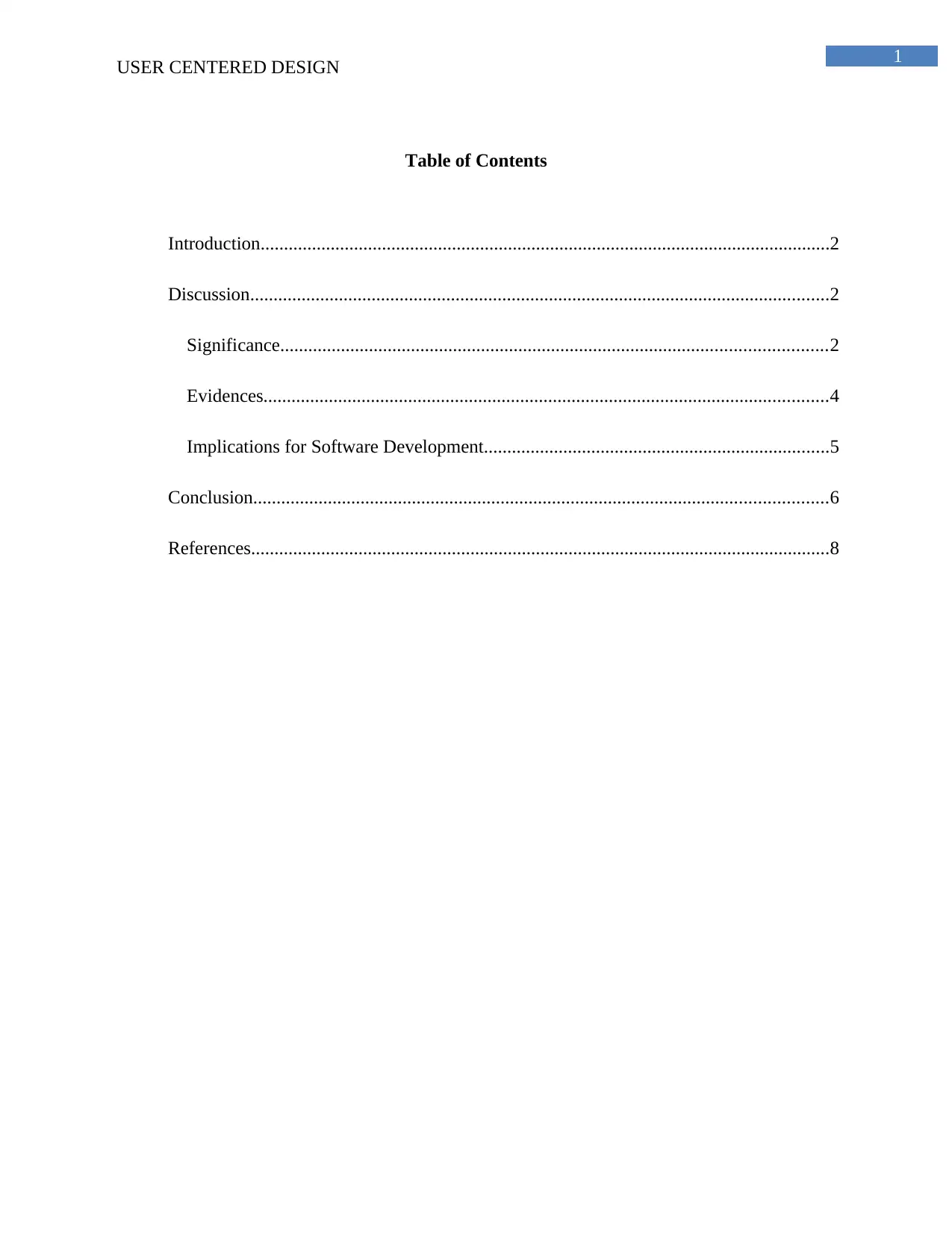
1
USER CENTERED DESIGN
Table of Contents
Introduction..........................................................................................................................2
Discussion............................................................................................................................2
Significance.....................................................................................................................2
Evidences.........................................................................................................................4
Implications for Software Development..........................................................................5
Conclusion...........................................................................................................................6
References............................................................................................................................8
USER CENTERED DESIGN
Table of Contents
Introduction..........................................................................................................................2
Discussion............................................................................................................................2
Significance.....................................................................................................................2
Evidences.........................................................................................................................4
Implications for Software Development..........................................................................5
Conclusion...........................................................................................................................6
References............................................................................................................................8
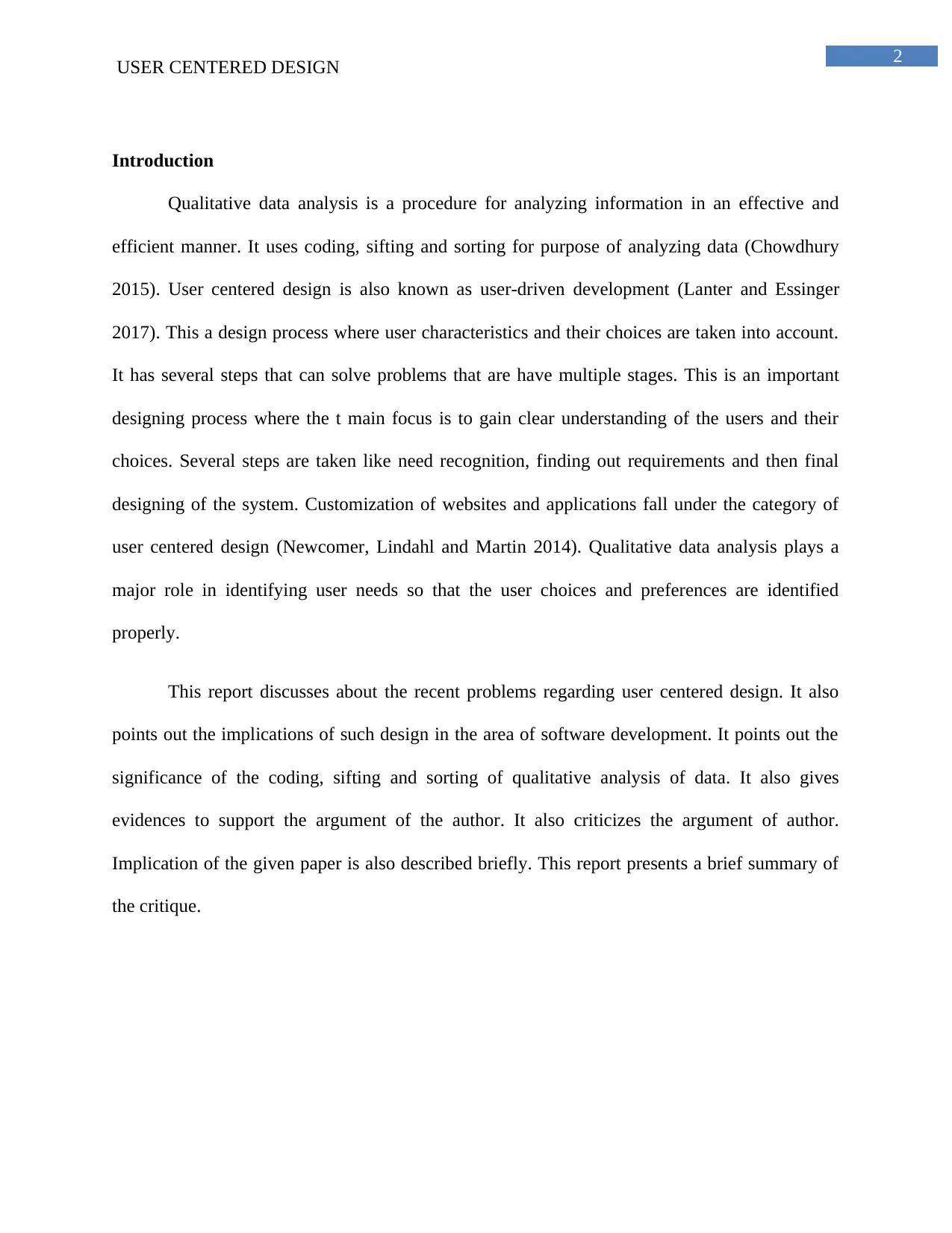
2
USER CENTERED DESIGN
Introduction
Qualitative data analysis is a procedure for analyzing information in an effective and
efficient manner. It uses coding, sifting and sorting for purpose of analyzing data (Chowdhury
2015). User centered design is also known as user-driven development (Lanter and Essinger
2017). This a design process where user characteristics and their choices are taken into account.
It has several steps that can solve problems that are have multiple stages. This is an important
designing process where the t main focus is to gain clear understanding of the users and their
choices. Several steps are taken like need recognition, finding out requirements and then final
designing of the system. Customization of websites and applications fall under the category of
user centered design (Newcomer, Lindahl and Martin 2014). Qualitative data analysis plays a
major role in identifying user needs so that the user choices and preferences are identified
properly.
This report discusses about the recent problems regarding user centered design. It also
points out the implications of such design in the area of software development. It points out the
significance of the coding, sifting and sorting of qualitative analysis of data. It also gives
evidences to support the argument of the author. It also criticizes the argument of author.
Implication of the given paper is also described briefly. This report presents a brief summary of
the critique.
USER CENTERED DESIGN
Introduction
Qualitative data analysis is a procedure for analyzing information in an effective and
efficient manner. It uses coding, sifting and sorting for purpose of analyzing data (Chowdhury
2015). User centered design is also known as user-driven development (Lanter and Essinger
2017). This a design process where user characteristics and their choices are taken into account.
It has several steps that can solve problems that are have multiple stages. This is an important
designing process where the t main focus is to gain clear understanding of the users and their
choices. Several steps are taken like need recognition, finding out requirements and then final
designing of the system. Customization of websites and applications fall under the category of
user centered design (Newcomer, Lindahl and Martin 2014). Qualitative data analysis plays a
major role in identifying user needs so that the user choices and preferences are identified
properly.
This report discusses about the recent problems regarding user centered design. It also
points out the implications of such design in the area of software development. It points out the
significance of the coding, sifting and sorting of qualitative analysis of data. It also gives
evidences to support the argument of the author. It also criticizes the argument of author.
Implication of the given paper is also described briefly. This report presents a brief summary of
the critique.
⊘ This is a preview!⊘
Do you want full access?
Subscribe today to unlock all pages.

Trusted by 1+ million students worldwide
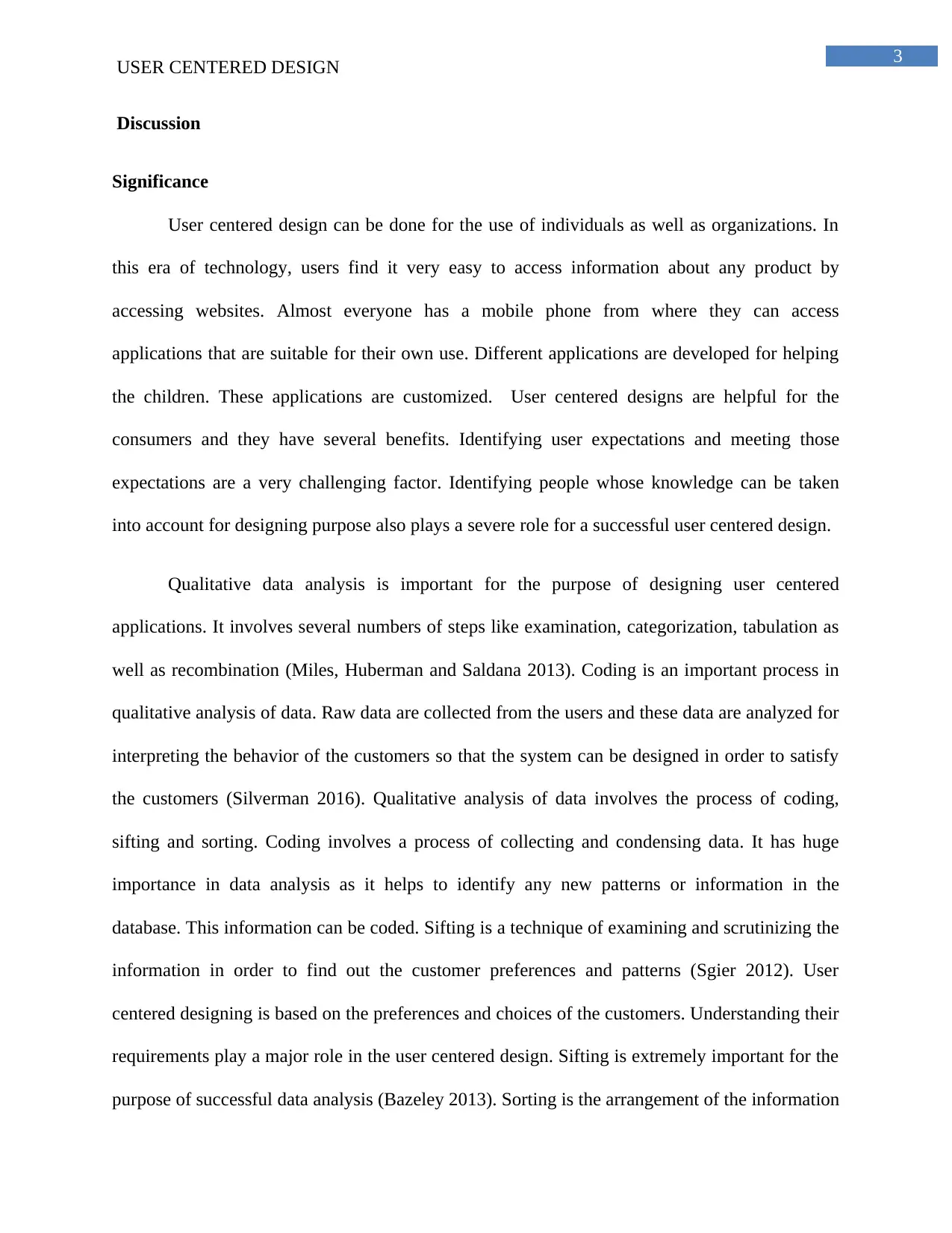
3
USER CENTERED DESIGN
Discussion
Significance
User centered design can be done for the use of individuals as well as organizations. In
this era of technology, users find it very easy to access information about any product by
accessing websites. Almost everyone has a mobile phone from where they can access
applications that are suitable for their own use. Different applications are developed for helping
the children. These applications are customized. User centered designs are helpful for the
consumers and they have several benefits. Identifying user expectations and meeting those
expectations are a very challenging factor. Identifying people whose knowledge can be taken
into account for designing purpose also plays a severe role for a successful user centered design.
Qualitative data analysis is important for the purpose of designing user centered
applications. It involves several numbers of steps like examination, categorization, tabulation as
well as recombination (Miles, Huberman and Saldana 2013). Coding is an important process in
qualitative analysis of data. Raw data are collected from the users and these data are analyzed for
interpreting the behavior of the customers so that the system can be designed in order to satisfy
the customers (Silverman 2016). Qualitative analysis of data involves the process of coding,
sifting and sorting. Coding involves a process of collecting and condensing data. It has huge
importance in data analysis as it helps to identify any new patterns or information in the
database. This information can be coded. Sifting is a technique of examining and scrutinizing the
information in order to find out the customer preferences and patterns (Sgier 2012). User
centered designing is based on the preferences and choices of the customers. Understanding their
requirements play a major role in the user centered design. Sifting is extremely important for the
purpose of successful data analysis (Bazeley 2013). Sorting is the arrangement of the information
USER CENTERED DESIGN
Discussion
Significance
User centered design can be done for the use of individuals as well as organizations. In
this era of technology, users find it very easy to access information about any product by
accessing websites. Almost everyone has a mobile phone from where they can access
applications that are suitable for their own use. Different applications are developed for helping
the children. These applications are customized. User centered designs are helpful for the
consumers and they have several benefits. Identifying user expectations and meeting those
expectations are a very challenging factor. Identifying people whose knowledge can be taken
into account for designing purpose also plays a severe role for a successful user centered design.
Qualitative data analysis is important for the purpose of designing user centered
applications. It involves several numbers of steps like examination, categorization, tabulation as
well as recombination (Miles, Huberman and Saldana 2013). Coding is an important process in
qualitative analysis of data. Raw data are collected from the users and these data are analyzed for
interpreting the behavior of the customers so that the system can be designed in order to satisfy
the customers (Silverman 2016). Qualitative analysis of data involves the process of coding,
sifting and sorting. Coding involves a process of collecting and condensing data. It has huge
importance in data analysis as it helps to identify any new patterns or information in the
database. This information can be coded. Sifting is a technique of examining and scrutinizing the
information in order to find out the customer preferences and patterns (Sgier 2012). User
centered designing is based on the preferences and choices of the customers. Understanding their
requirements play a major role in the user centered design. Sifting is extremely important for the
purpose of successful data analysis (Bazeley 2013). Sorting is the arrangement of the information
Paraphrase This Document
Need a fresh take? Get an instant paraphrase of this document with our AI Paraphraser
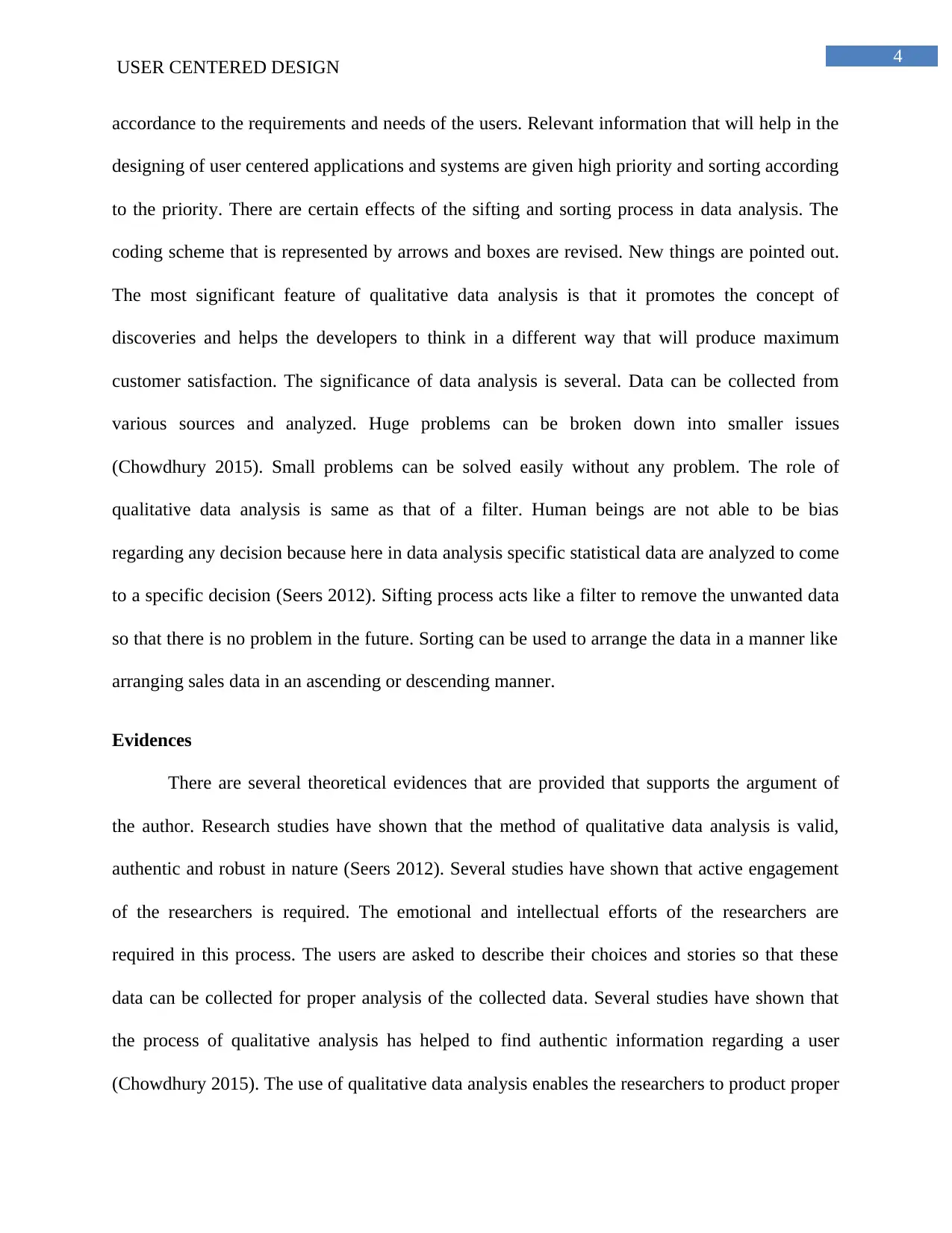
4
USER CENTERED DESIGN
accordance to the requirements and needs of the users. Relevant information that will help in the
designing of user centered applications and systems are given high priority and sorting according
to the priority. There are certain effects of the sifting and sorting process in data analysis. The
coding scheme that is represented by arrows and boxes are revised. New things are pointed out.
The most significant feature of qualitative data analysis is that it promotes the concept of
discoveries and helps the developers to think in a different way that will produce maximum
customer satisfaction. The significance of data analysis is several. Data can be collected from
various sources and analyzed. Huge problems can be broken down into smaller issues
(Chowdhury 2015). Small problems can be solved easily without any problem. The role of
qualitative data analysis is same as that of a filter. Human beings are not able to be bias
regarding any decision because here in data analysis specific statistical data are analyzed to come
to a specific decision (Seers 2012). Sifting process acts like a filter to remove the unwanted data
so that there is no problem in the future. Sorting can be used to arrange the data in a manner like
arranging sales data in an ascending or descending manner.
Evidences
There are several theoretical evidences that are provided that supports the argument of
the author. Research studies have shown that the method of qualitative data analysis is valid,
authentic and robust in nature (Seers 2012). Several studies have shown that active engagement
of the researchers is required. The emotional and intellectual efforts of the researchers are
required in this process. The users are asked to describe their choices and stories so that these
data can be collected for proper analysis of the collected data. Several studies have shown that
the process of qualitative analysis has helped to find authentic information regarding a user
(Chowdhury 2015). The use of qualitative data analysis enables the researchers to product proper
USER CENTERED DESIGN
accordance to the requirements and needs of the users. Relevant information that will help in the
designing of user centered applications and systems are given high priority and sorting according
to the priority. There are certain effects of the sifting and sorting process in data analysis. The
coding scheme that is represented by arrows and boxes are revised. New things are pointed out.
The most significant feature of qualitative data analysis is that it promotes the concept of
discoveries and helps the developers to think in a different way that will produce maximum
customer satisfaction. The significance of data analysis is several. Data can be collected from
various sources and analyzed. Huge problems can be broken down into smaller issues
(Chowdhury 2015). Small problems can be solved easily without any problem. The role of
qualitative data analysis is same as that of a filter. Human beings are not able to be bias
regarding any decision because here in data analysis specific statistical data are analyzed to come
to a specific decision (Seers 2012). Sifting process acts like a filter to remove the unwanted data
so that there is no problem in the future. Sorting can be used to arrange the data in a manner like
arranging sales data in an ascending or descending manner.
Evidences
There are several theoretical evidences that are provided that supports the argument of
the author. Research studies have shown that the method of qualitative data analysis is valid,
authentic and robust in nature (Seers 2012). Several studies have shown that active engagement
of the researchers is required. The emotional and intellectual efforts of the researchers are
required in this process. The users are asked to describe their choices and stories so that these
data can be collected for proper analysis of the collected data. Several studies have shown that
the process of qualitative analysis has helped to find authentic information regarding a user
(Chowdhury 2015). The use of qualitative data analysis enables the researchers to product proper
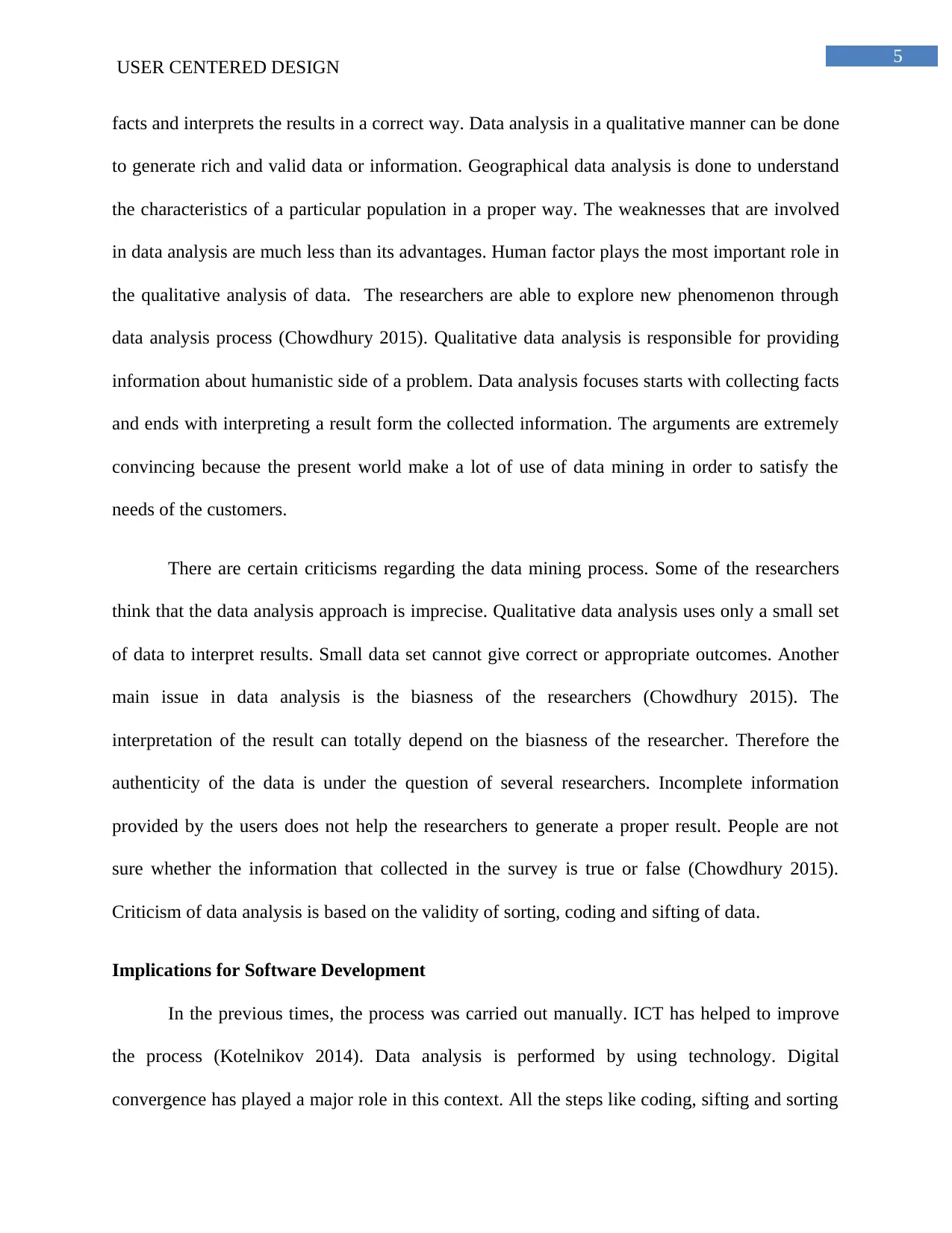
5
USER CENTERED DESIGN
facts and interprets the results in a correct way. Data analysis in a qualitative manner can be done
to generate rich and valid data or information. Geographical data analysis is done to understand
the characteristics of a particular population in a proper way. The weaknesses that are involved
in data analysis are much less than its advantages. Human factor plays the most important role in
the qualitative analysis of data. The researchers are able to explore new phenomenon through
data analysis process (Chowdhury 2015). Qualitative data analysis is responsible for providing
information about humanistic side of a problem. Data analysis focuses starts with collecting facts
and ends with interpreting a result form the collected information. The arguments are extremely
convincing because the present world make a lot of use of data mining in order to satisfy the
needs of the customers.
There are certain criticisms regarding the data mining process. Some of the researchers
think that the data analysis approach is imprecise. Qualitative data analysis uses only a small set
of data to interpret results. Small data set cannot give correct or appropriate outcomes. Another
main issue in data analysis is the biasness of the researchers (Chowdhury 2015). The
interpretation of the result can totally depend on the biasness of the researcher. Therefore the
authenticity of the data is under the question of several researchers. Incomplete information
provided by the users does not help the researchers to generate a proper result. People are not
sure whether the information that collected in the survey is true or false (Chowdhury 2015).
Criticism of data analysis is based on the validity of sorting, coding and sifting of data.
Implications for Software Development
In the previous times, the process was carried out manually. ICT has helped to improve
the process (Kotelnikov 2014). Data analysis is performed by using technology. Digital
convergence has played a major role in this context. All the steps like coding, sifting and sorting
USER CENTERED DESIGN
facts and interprets the results in a correct way. Data analysis in a qualitative manner can be done
to generate rich and valid data or information. Geographical data analysis is done to understand
the characteristics of a particular population in a proper way. The weaknesses that are involved
in data analysis are much less than its advantages. Human factor plays the most important role in
the qualitative analysis of data. The researchers are able to explore new phenomenon through
data analysis process (Chowdhury 2015). Qualitative data analysis is responsible for providing
information about humanistic side of a problem. Data analysis focuses starts with collecting facts
and ends with interpreting a result form the collected information. The arguments are extremely
convincing because the present world make a lot of use of data mining in order to satisfy the
needs of the customers.
There are certain criticisms regarding the data mining process. Some of the researchers
think that the data analysis approach is imprecise. Qualitative data analysis uses only a small set
of data to interpret results. Small data set cannot give correct or appropriate outcomes. Another
main issue in data analysis is the biasness of the researchers (Chowdhury 2015). The
interpretation of the result can totally depend on the biasness of the researcher. Therefore the
authenticity of the data is under the question of several researchers. Incomplete information
provided by the users does not help the researchers to generate a proper result. People are not
sure whether the information that collected in the survey is true or false (Chowdhury 2015).
Criticism of data analysis is based on the validity of sorting, coding and sifting of data.
Implications for Software Development
In the previous times, the process was carried out manually. ICT has helped to improve
the process (Kotelnikov 2014). Data analysis is performed by using technology. Digital
convergence has played a major role in this context. All the steps like coding, sifting and sorting
⊘ This is a preview!⊘
Do you want full access?
Subscribe today to unlock all pages.

Trusted by 1+ million students worldwide
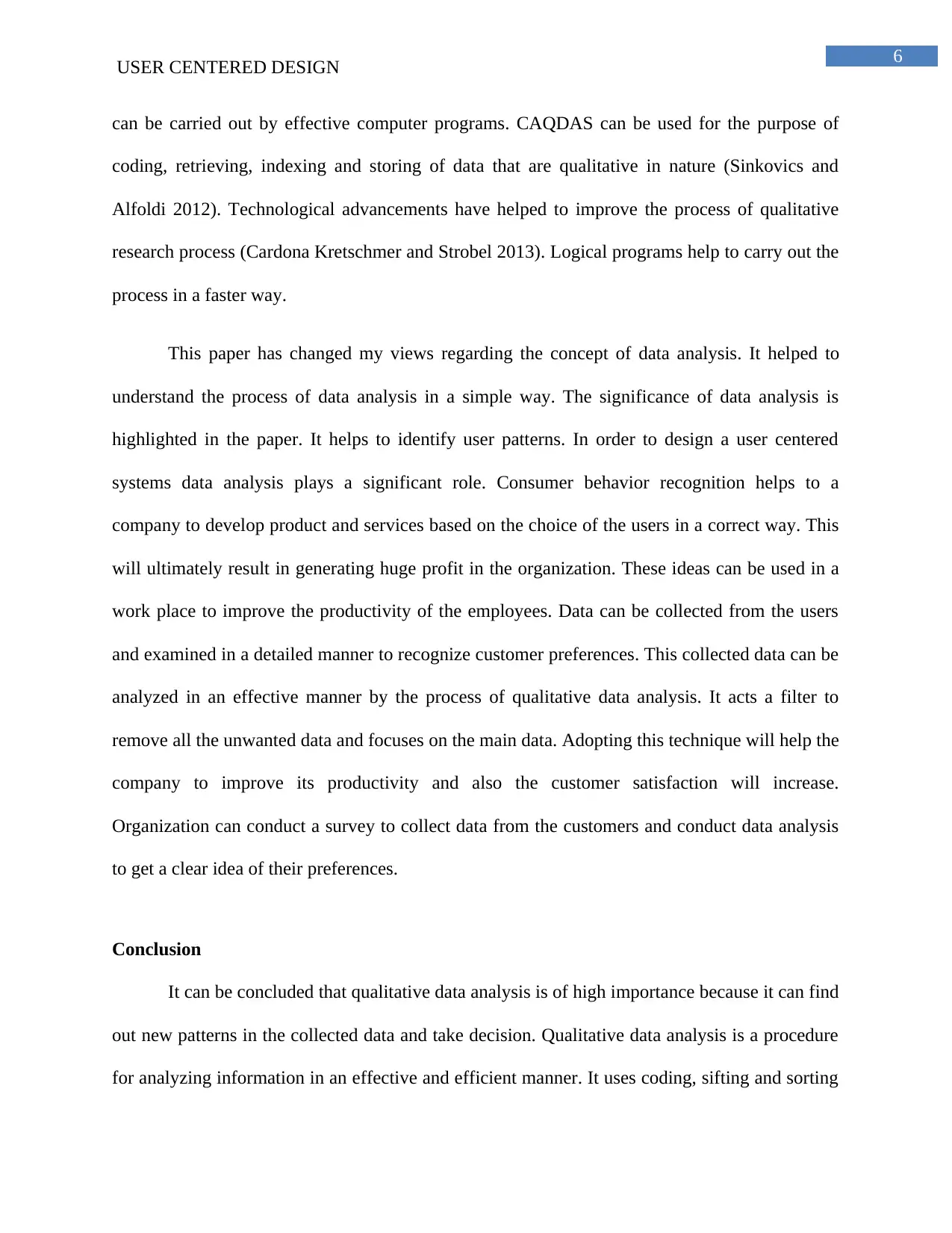
6
USER CENTERED DESIGN
can be carried out by effective computer programs. CAQDAS can be used for the purpose of
coding, retrieving, indexing and storing of data that are qualitative in nature (Sinkovics and
Alfoldi 2012). Technological advancements have helped to improve the process of qualitative
research process (Cardona Kretschmer and Strobel 2013). Logical programs help to carry out the
process in a faster way.
This paper has changed my views regarding the concept of data analysis. It helped to
understand the process of data analysis in a simple way. The significance of data analysis is
highlighted in the paper. It helps to identify user patterns. In order to design a user centered
systems data analysis plays a significant role. Consumer behavior recognition helps to a
company to develop product and services based on the choice of the users in a correct way. This
will ultimately result in generating huge profit in the organization. These ideas can be used in a
work place to improve the productivity of the employees. Data can be collected from the users
and examined in a detailed manner to recognize customer preferences. This collected data can be
analyzed in an effective manner by the process of qualitative data analysis. It acts a filter to
remove all the unwanted data and focuses on the main data. Adopting this technique will help the
company to improve its productivity and also the customer satisfaction will increase.
Organization can conduct a survey to collect data from the customers and conduct data analysis
to get a clear idea of their preferences.
Conclusion
It can be concluded that qualitative data analysis is of high importance because it can find
out new patterns in the collected data and take decision. Qualitative data analysis is a procedure
for analyzing information in an effective and efficient manner. It uses coding, sifting and sorting
USER CENTERED DESIGN
can be carried out by effective computer programs. CAQDAS can be used for the purpose of
coding, retrieving, indexing and storing of data that are qualitative in nature (Sinkovics and
Alfoldi 2012). Technological advancements have helped to improve the process of qualitative
research process (Cardona Kretschmer and Strobel 2013). Logical programs help to carry out the
process in a faster way.
This paper has changed my views regarding the concept of data analysis. It helped to
understand the process of data analysis in a simple way. The significance of data analysis is
highlighted in the paper. It helps to identify user patterns. In order to design a user centered
systems data analysis plays a significant role. Consumer behavior recognition helps to a
company to develop product and services based on the choice of the users in a correct way. This
will ultimately result in generating huge profit in the organization. These ideas can be used in a
work place to improve the productivity of the employees. Data can be collected from the users
and examined in a detailed manner to recognize customer preferences. This collected data can be
analyzed in an effective manner by the process of qualitative data analysis. It acts a filter to
remove all the unwanted data and focuses on the main data. Adopting this technique will help the
company to improve its productivity and also the customer satisfaction will increase.
Organization can conduct a survey to collect data from the customers and conduct data analysis
to get a clear idea of their preferences.
Conclusion
It can be concluded that qualitative data analysis is of high importance because it can find
out new patterns in the collected data and take decision. Qualitative data analysis is a procedure
for analyzing information in an effective and efficient manner. It uses coding, sifting and sorting
Paraphrase This Document
Need a fresh take? Get an instant paraphrase of this document with our AI Paraphraser
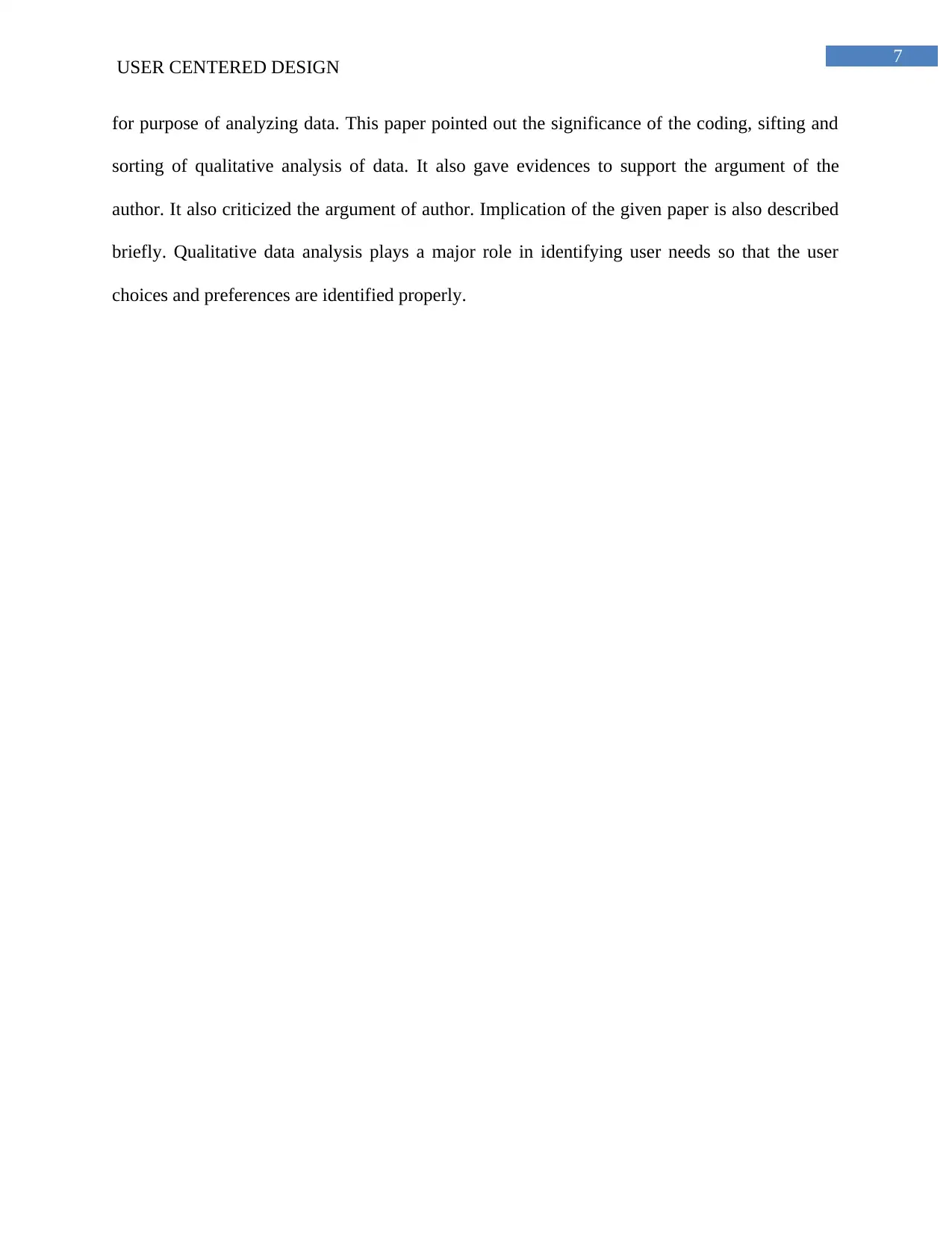
7
USER CENTERED DESIGN
for purpose of analyzing data. This paper pointed out the significance of the coding, sifting and
sorting of qualitative analysis of data. It also gave evidences to support the argument of the
author. It also criticized the argument of author. Implication of the given paper is also described
briefly. Qualitative data analysis plays a major role in identifying user needs so that the user
choices and preferences are identified properly.
USER CENTERED DESIGN
for purpose of analyzing data. This paper pointed out the significance of the coding, sifting and
sorting of qualitative analysis of data. It also gave evidences to support the argument of the
author. It also criticized the argument of author. Implication of the given paper is also described
briefly. Qualitative data analysis plays a major role in identifying user needs so that the user
choices and preferences are identified properly.
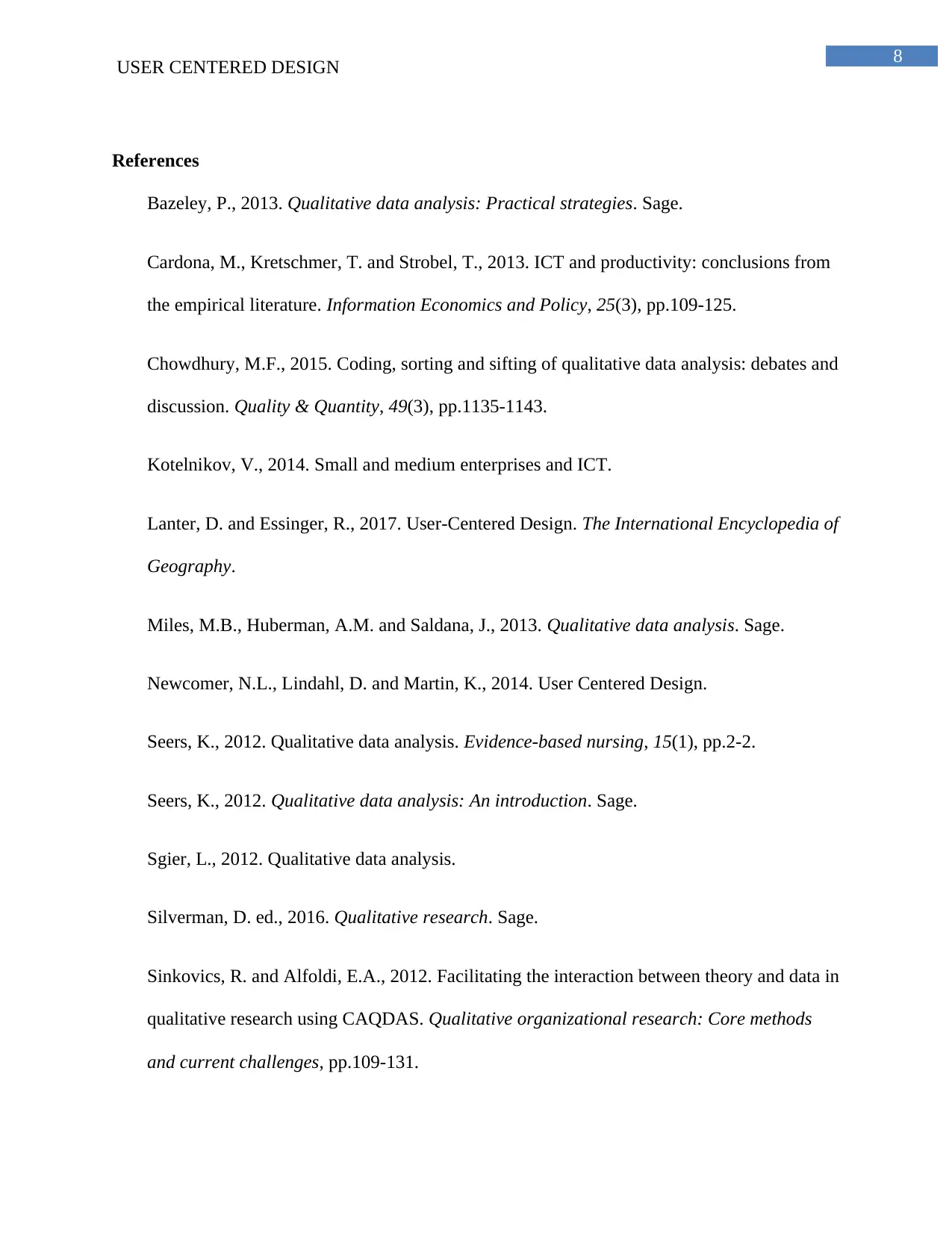
8
USER CENTERED DESIGN
References
Bazeley, P., 2013. Qualitative data analysis: Practical strategies. Sage.
Cardona, M., Kretschmer, T. and Strobel, T., 2013. ICT and productivity: conclusions from
the empirical literature. Information Economics and Policy, 25(3), pp.109-125.
Chowdhury, M.F., 2015. Coding, sorting and sifting of qualitative data analysis: debates and
discussion. Quality & Quantity, 49(3), pp.1135-1143.
Kotelnikov, V., 2014. Small and medium enterprises and ICT.
Lanter, D. and Essinger, R., 2017. User‐Centered Design. The International Encyclopedia of
Geography.
Miles, M.B., Huberman, A.M. and Saldana, J., 2013. Qualitative data analysis. Sage.
Newcomer, N.L., Lindahl, D. and Martin, K., 2014. User Centered Design.
Seers, K., 2012. Qualitative data analysis. Evidence-based nursing, 15(1), pp.2-2.
Seers, K., 2012. Qualitative data analysis: An introduction. Sage.
Sgier, L., 2012. Qualitative data analysis.
Silverman, D. ed., 2016. Qualitative research. Sage.
Sinkovics, R. and Alfoldi, E.A., 2012. Facilitating the interaction between theory and data in
qualitative research using CAQDAS. Qualitative organizational research: Core methods
and current challenges, pp.109-131.
USER CENTERED DESIGN
References
Bazeley, P., 2013. Qualitative data analysis: Practical strategies. Sage.
Cardona, M., Kretschmer, T. and Strobel, T., 2013. ICT and productivity: conclusions from
the empirical literature. Information Economics and Policy, 25(3), pp.109-125.
Chowdhury, M.F., 2015. Coding, sorting and sifting of qualitative data analysis: debates and
discussion. Quality & Quantity, 49(3), pp.1135-1143.
Kotelnikov, V., 2014. Small and medium enterprises and ICT.
Lanter, D. and Essinger, R., 2017. User‐Centered Design. The International Encyclopedia of
Geography.
Miles, M.B., Huberman, A.M. and Saldana, J., 2013. Qualitative data analysis. Sage.
Newcomer, N.L., Lindahl, D. and Martin, K., 2014. User Centered Design.
Seers, K., 2012. Qualitative data analysis. Evidence-based nursing, 15(1), pp.2-2.
Seers, K., 2012. Qualitative data analysis: An introduction. Sage.
Sgier, L., 2012. Qualitative data analysis.
Silverman, D. ed., 2016. Qualitative research. Sage.
Sinkovics, R. and Alfoldi, E.A., 2012. Facilitating the interaction between theory and data in
qualitative research using CAQDAS. Qualitative organizational research: Core methods
and current challenges, pp.109-131.
⊘ This is a preview!⊘
Do you want full access?
Subscribe today to unlock all pages.

Trusted by 1+ million students worldwide

9
USER CENTERED DESIGN
USER CENTERED DESIGN
1 out of 10
Related Documents
Your All-in-One AI-Powered Toolkit for Academic Success.
+13062052269
info@desklib.com
Available 24*7 on WhatsApp / Email
![[object Object]](/_next/static/media/star-bottom.7253800d.svg)
Unlock your academic potential
Copyright © 2020–2025 A2Z Services. All Rights Reserved. Developed and managed by ZUCOL.





